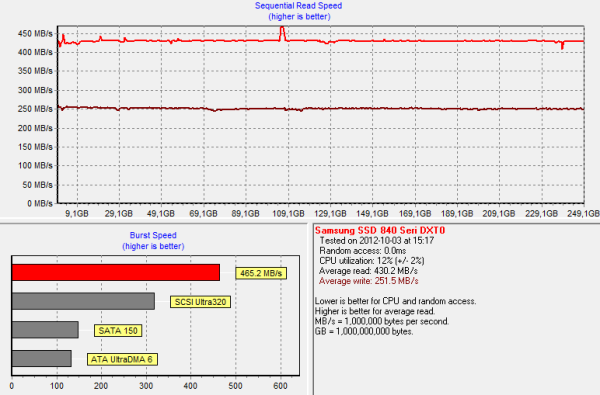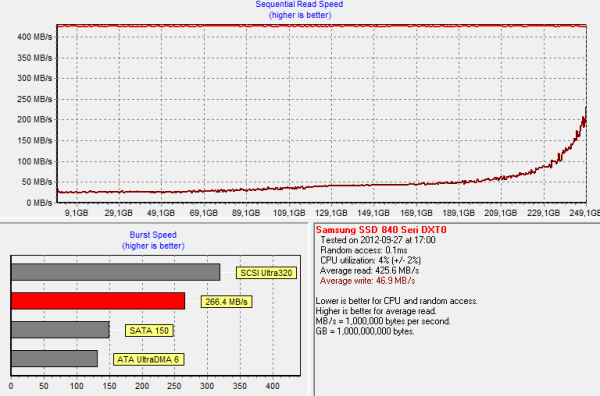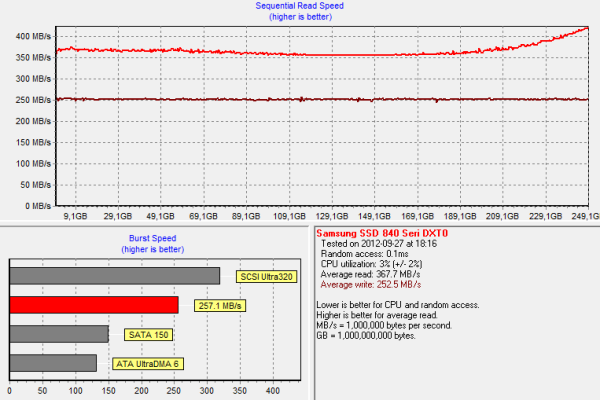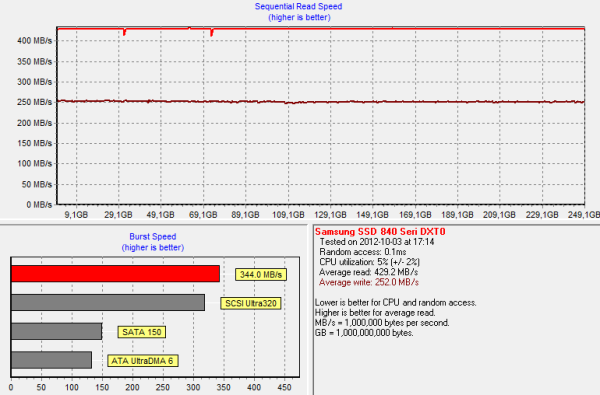Samsung SSD 840 (250GB) Review
by Kristian Vättö on October 8, 2012 12:14 PM EST- Posted in
- Storage
- SSDs
- Samsung
- TLC
- Samsung SSD 840
Performance Over Time & TRIM
For starters, I ran HDtach on a secure erased drive to get the baseline performance:
Next I secure erased the drive again, filled it with compressible data and proceeded with torturing it for 20 minutes with compressible 4KB random writes (100% LBA space, QD=32):
Ouch, performance takes a big hit. Usually 20 minutes isn't enough to put 256GB drives on their knees but it definitely is for the 840. Write speed drops to as low as 25MB/s, although it's nearly restored before all user-accessible LBAs have been filled. The way to avoid this worst case state is to keep as much free space on your drive as possible. We typically recommend around 20%, however with TLC NAND it might be advisable to bump that up to 30%. The 840 Pro will be a better option for heavy write workloads already due to its higher endurance.
To see how idle time is able to restore performance, I let the drive idle for 50 minutes:
Write speed is fully restored but for some reason, read speed is fluctuating. The drop isn't huge as we are still talking about +350MB/s at all times, but it's interesting and a bit odd to see this kind of behavior since read speed was ~425MB/s after torture.
Finally I secure erased the drive again, filled it, tortured for 20 minutes and TRIM'ed it:
Again we see some weird behavior as write speed is not fully restored after TRIM. It does get to 250MB/s at the end of the HDtach run, but the starting performance is only 150MB/s. Keep in mind that I TRIM'ed the drive right after the torture; I didn't run HDtach in between like we often do but a functioning TRIM should still fully restore performance. Remember that TRIM is still just a suggestion—it's up to the controller to prioritize TRIMed LBAs for garbage collection. Given the higher program/erase latencies with TLC NAND it's entirely possible that the 840's garbage collection routine is just slower than we're used to seeing. Another possibility is that with the fewer number of P/E cycles, the 840 is just very conservative about using them when it's not stricly necessary (e.g. ignoring some of the TRIM "suggestions").
As a final test, I TRIM'ed the drive again and ran HDtach:
And now performance is what it should be. This is mostly due to sequential writes because at the end of the previous HDtach run, write performance was already at 250MB/s.















86 Comments
View All Comments
xdrol - Monday, October 8, 2012 - link
You sir need to learn how SSDs work. Static data is not static on the flash chip - the controller shuffles it around, exactly because of wear levelling.name99 - Tuesday, October 9, 2012 - link
"I think Kristian should have made this all more clear because too many people don't bother to actually read stuff and just look at charts."Kristian is not the problem.
There is a bizarre fraction of the world of tech "enthusiasts" who are convinced that every change in the world is a conspiracy to screw them over.
These people have been obsessing about the supposed fragility of flash memory from day one. We have YEARS of real world experience with these devices but it means nothing to them. We haven't been screwed yet, but with TLC it's coming, I tell you.
The same people spent years insisting that non-replacable batteries were a disaster waiting to happen.
Fifteen years ago they were whining about the iMac not including a floppy drive, for the past few years they have been whining about recent computers not including an optical drive.
A few weeks ago we saw the exact same thing regarding Apple's new Lightning connector.
The thing you have to remember about these people is
- evidence means NOTHING. you can tell them all the figures you want, about .1% failure rates, or minuscule return rates or whatever. None of that counts against their gut feeling that this won't work, or even better an anecdote that some guy some somewhere had a problem.
- they have NO sense of history. Even if they lived through these transitions before, they cannot see how changes in 2000 are relevant to changes in 2012.
- they will NEVER admit that they were wrong. The best you can possibly get out of them is a grudging acceptance that, yeah, Apple was right to get rid of floppy disks, but they did it too soon.
In other words these are fools that are best ignored. They have zero knowledge of history, zero knowledge of the market, zero knowledge of the technology --- and the grandiose opinions that come from not actually knowing any pesky details or facts.
piiman - Tuesday, February 19, 2013 - link
Then stick with Intel not because they last longer but they have a great warranty.(5 years) My drive went bad at about 3.5 years and Intel replaced it no questions asked and did it very quickly. I sent it in and had a new one 2 days after they received my old one. great service!GTRagnarok - Monday, October 8, 2012 - link
This is assuming a very exaggerated amplification of 10x.Kristian Vättö - Monday, October 8, 2012 - link
Keep in mind that it's an estimation based on the example numbers. 10x write amplification is fairly high for consumer workloads, most usually have something between 1-3x (though it gets a big bigger when taking wear leveling efficiency into account). Either way, we played safe and used 10x.Furthermore, the reported P/E cycle counts are the minimums. You have to be conservative when doing endurance ratings because every single die you sell must be able to achieve that. Hence it's completely possible (and even likely) that TLC can do more than 1,000 P/E cycles. It may be 1,500 or 3,000, I don't know; but 1,000 is the minimum. There is a Samsung 830 at XtremeSystems (had to remove the link as our system thought it was spam, LOL) that has lasted for more than 3,000TiBs, which would translate to over 10,000 P/E cycles (supposedly, that NAND is rated at 3,000 cycles).
Of course, as mentioned at the end of the review, the 840 is something you would recommend to a light user (think about your parents or grandparents for instance), whereas the 840 Pro is the drive for heavier users. Those users are not writing a lot (heck, they may not use their system for days!), hence the endurance is not an issue.
A5 - Monday, October 8, 2012 - link
Ah. I didn't know the 10x WA number was exceedingly conservative. Nevermind, then.TheinsanegamerN - Friday, July 5, 2013 - link
3.5 years is considering you are writing 36.5 GB of data a day. if the computer it is sitting in is mostly used for online work of document editing, youll get far more. the laptop would probably die long before the ssd did.also, this only apples to the tls ssds. mlc ssds last 3 times longer, so the 840 pro would be better for a computer kept longer than 3 years.
Vepsa - Monday, October 8, 2012 - link
Might just be able to convince the wife that this is the way to go for her computer and my computer.CaedenV - Monday, October 8, 2012 - link
That is how I did it. My wife's old 80GB system drive died a bit over a year ago, and it was one of those issues of $75 for a decent HDD, or $100 for an SSD that would be 'big enough' for her as a system drive (60GB at the time). So I spent the extra $25, and it made her ~5 year old Core2Duo machine faster (for day-to-day workloads) than my brand new i7 monster that I had just build (but was still using traditional HDD at the time).I eventually got so frustrated by the performance difference that I ended up finally getting one for myself, and then after my birthday came then I spent my fun money on a 2nd one for RAID0. It did not make a huge performance increase (I mean it was faster in benchmarks, but doubling the speed of instant is still instant lol), but it did allow me to have enough space to load all my programs on the SSD instead of being divided between the SSD and HDD.
AndersLund - Sunday, November 25, 2012 - link
Notice, that setting up a RAID with your SSD might hinder the OS to see the SSDs as SSD and not sending TRIM commands to the disks. My first (and current) gamer system consists of two Intel 80 GB SSD in a RAID0 setup, but the OS (and Intel's toolbox) does not recognize them as SSD.